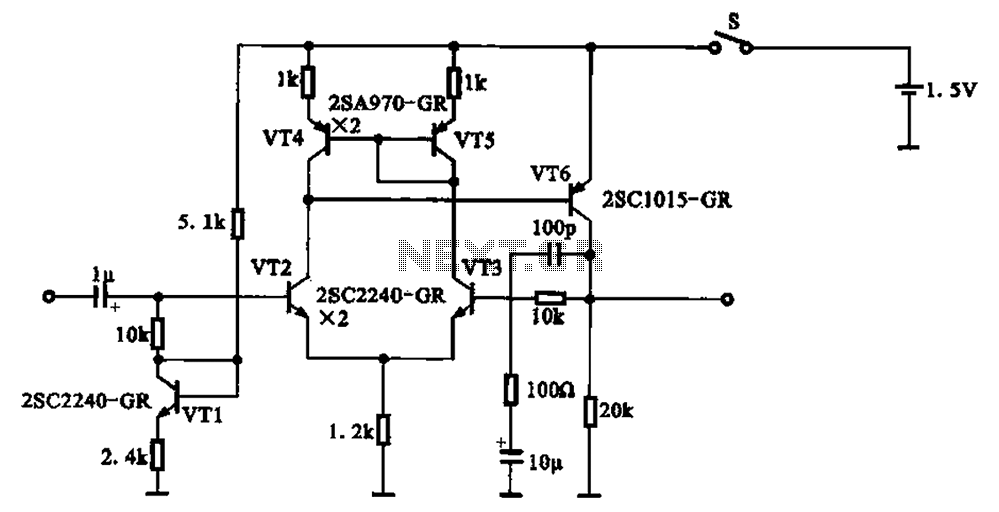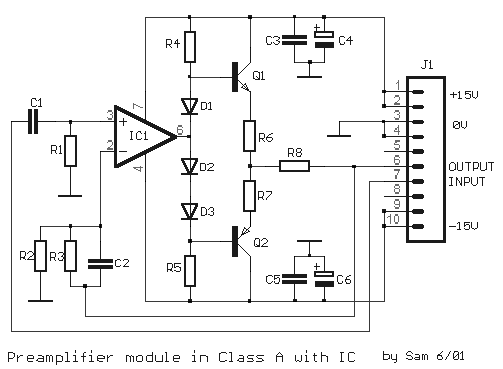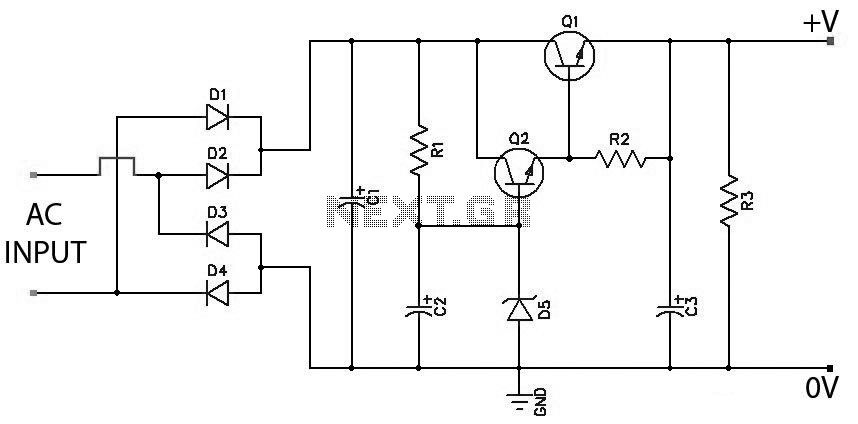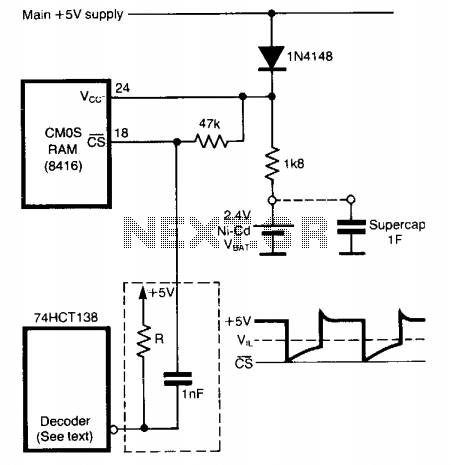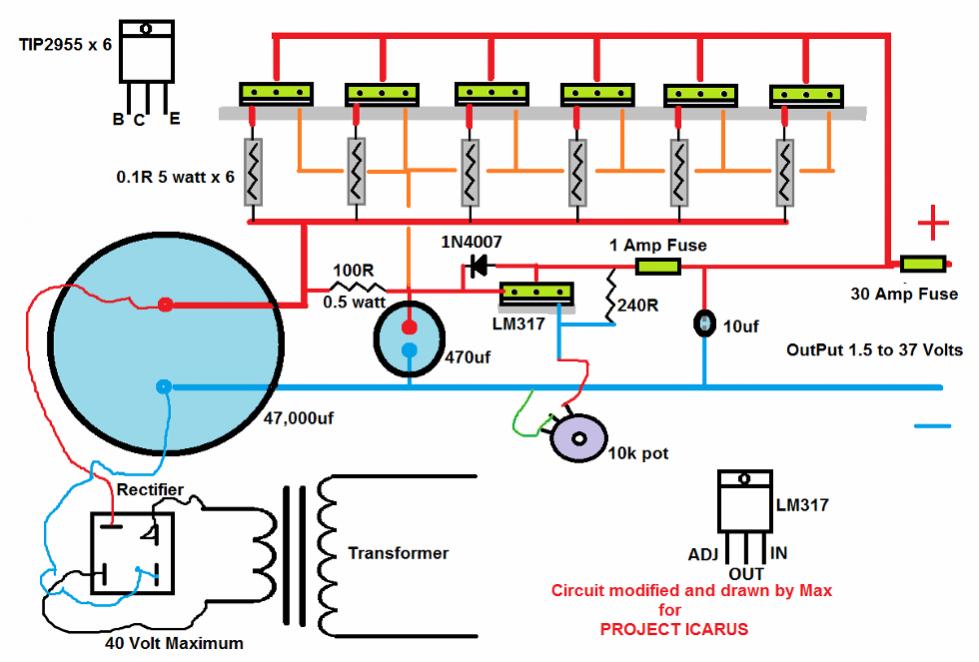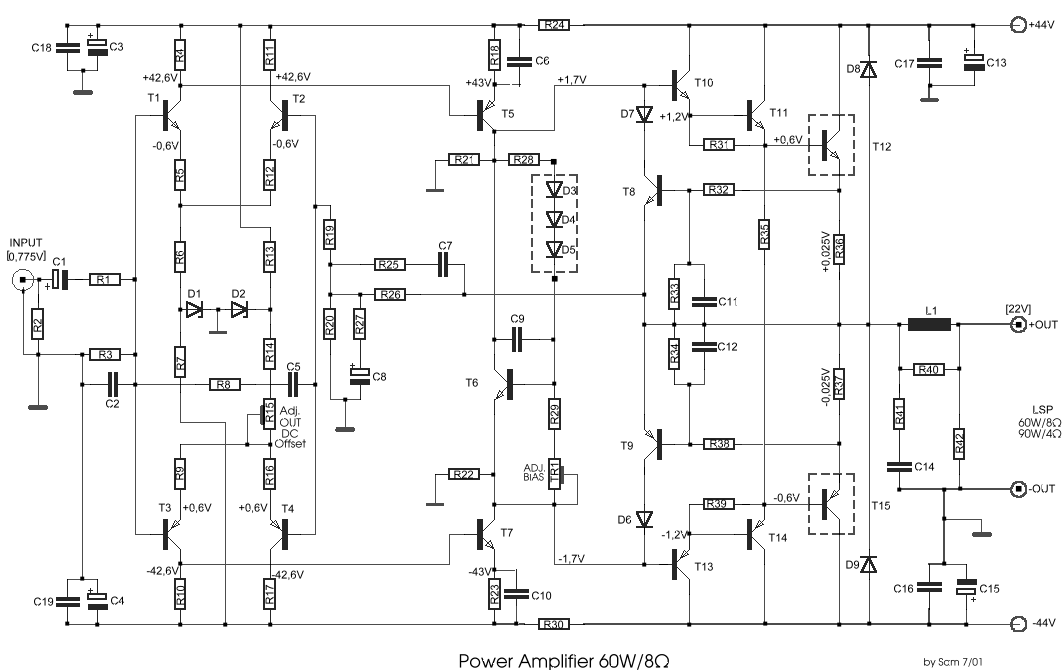
optocouplers safely isolate integrated power modules
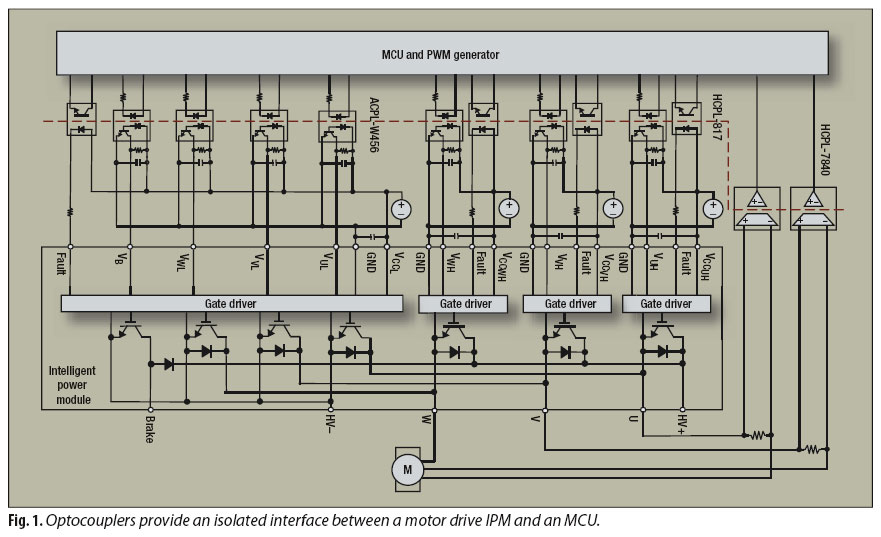
An interface circuit utilizing optocouplers provides galvanic isolation and common-mode noise rejection between low-voltage microcontroller units and high-voltage integrated power modules in motor-drive applications. Optocouplers ensure high-voltage isolation between a low-voltage device, such as a microcontroller or a pulse-width modulation (PWM) generator, and a high-voltage device like an intelligent or integrated power module (IPM). The optocoupler is a critical interface device, as all high-voltage circuits must comply with safety standards, including IEC 60950 for IT equipment and IEC 60335 for household appliances. During testing for these standards, a high voltage is applied between the low-voltage and high-voltage ports of the equipment. In these systems, optocouplers isolate the low- to high-voltage interface to meet safety and protection standards. Relevant semiconductor component electrical safety standards for optocouplers include IEC 60747-5-2 and UL 1577. Designers can select suitable optocouplers based on applicable equipment safety standards. Key parameters related to equipment safety ratings include working voltage, pollution degree, installation class, and insulation level. Various safety standards for industrial, home, office, and IT equipment necessitate reinforced insulation levels for electrical equipment powered by the AC line. Specific parameters defined by equipment safety standards include external clearance, creepage, distance through insulation (DTI) or internal clearance, and comparative tracking index (CTI). A diagram illustrates a motor-drive circuit connecting a microcontroller unit (MCU) and an IPM. Seven digital optocoupler units (ACPL-W456) isolate the IPM's seven gate driver inputs—one for the brake and six for the IGBTs. Two HCPL-7840 isolated amplifiers provide linear feedback from two motor phases to the MCU, using voltage sampling from two shunt resistors. Additionally, four HCPL-817 general-purpose phototransistor-type optocouplers isolate the IPM's fault feedback signals. All these optocouplers comply with reinforced safety-protection levels, ensuring a galvanic isolation boundary between low- and high-voltage circuits. A three-phase IPM employs six gate drivers for six high- and low-side IGBTs, each requiring a 10-V to 30-V power supply. The emitters of the low-side IGBTs connect to the DC bus HV- as a common reference ground, allowing all low-side gate drivers to share the same power supply (VCC_L - GND1). Overtemperature and overcurrent protection functions are integrated, providing a fault signal feedback to the host microcontroller. The emitter of the high-side IGBT and the collector of the low-side IGBT connect to form one leg of a three-phase switch. By alternately activating high-side and low-side IGBTs, the HV DC bus voltage switches the output to the respective U, V, or W load phase. The three-phase vectors are 120 degrees apart. With the ground connected to the collector of the low-side IGBTs, the ground of each high-side gate driver circuit oscillates between HV- and HV+. Consequently, the ground of each power supply for the high-side IGBT gate driver circuit must float and be isolated from one another. A more robust solution involves providing three isolated power supplies for each high-side gate driver circuit. Bootstrapping the power supply with individual floating grounds serves as a cost-effective alternative. Bootstrapping power supplies can be derived from either the DC bus voltage or the low-side power supply (VCC_L). Conventional IPM input logic and gate-driving circuits are integrated into a monolithic IC, with power supply requirements ranging from 15 V to 20 V. This conventional IPM operates with inverted logic; when the input voltage is high, the IGBT turns off, and when the input voltage is low, the IGBT turns on.
The described interface circuit is crucial for ensuring safe and reliable operation in motor-drive applications where both low and high voltage components are present. The use of optocouplers not only fulfills safety requirements but also enhances system performance by minimizing noise and interference. In practical applications, the selection of optocouplers must be based on their voltage ratings, isolation characteristics, and compliance with relevant safety standards, ensuring that the circuit can operate effectively under various conditions.
The integration of isolated amplifiers for feedback from the motor phases is essential for maintaining control over the motor's performance. These amplifiers provide critical information about the current running through the motor, allowing the microcontroller to make real-time adjustments to optimize performance and protect against overcurrent conditions.
Furthermore, the design of the power supply for the gate drivers is a significant consideration. The requirement for floating grounds in high-side driver circuits is a common challenge in power electronics. The implementation of bootstrapping techniques can simplify the power supply design while ensuring that each gate driver functions correctly, even as the high-side IGBTs switch states.
In summary, the interface circuit utilizing optocouplers and isolated feedback mechanisms is a sophisticated solution for the challenges faced in high-voltage motor-drive applications. The careful selection of components and adherence to safety standards are paramount in creating a reliable and efficient system.An interface circuit based on optocouplers provides galvanic isolation and common-mode noise rejection between low-voltage microcontroller units and high-voltage integrated power modules in motor-drive applications. Optocouplers provide high-voltage isolation between a low-voltage device like a microcontroller or a pulse-width modulation (PWM) gen
erator and a high-voltage device like an intelligent or integrated power module (IPM). The optocoupler is a key interface device because every high-voltage circuit must be compliant with equipment safety standards, such as IEC 60950 for IT equipment and IEC 60335 for household appliances. In testing for these standards, a high voltage is usually applied between low-voltage and high-voltage ports of the equipment.
In these systems, the optocoupler isolates the low- to high-voltage interface to meet safety and protection standards. Some common semiconductor component electrical safety standards applicable to optocouplers are IEC 60747-5-2 and UL 1577.
A designer can select the appropriate optocouplers based on the relevant equipment safety standards. The table lists the characteristics of some optocouplers intended for high-voltage isolation. The key optocoupler parameters related to equipment safety ratings are working voltage, polluting degree, installation class and insulation level. Various safety standards for industrial, home, office and IT equipment require a reinforced insulation level for electrical equipment powered by the ac line.
Some parameters specified by equipment safety standards include external clearance, creepage, distance through insulation (DTI) or internal clearance, and comparative tracking index (CTI). Fig. 1 shows a diagram of a motor-drive circuit between a microcontroller unit (MCU) and an IPM. Seven units of digital optocoupler ACPL-W456 isolate the IPM`s seven gate driver inputs, one for the brake and six for the IGBTs.
Using voltage sampling from two shunt resistors, two HCPL-7840 isolated amplifiers provide linear feedback from two motor phases to the MCU. Four HCPL-817 general-purpose phototransistor-type optocouplers isolate the IPM`s fault feedback signals.
All these optocouplers are compliant with reinforced safety-protection levels, because they secure a galvanic isolation boundary between low- and high-voltage circuits. A three-phase IPM employs six gate drivers each for six high- and low-side IGBTs. Each gate driver needs a 10-V to 30-V power supply. The emitters of the low-side IGBT connect to the dc bus HV- as common reference ground, which allows all low-side gate drivers to share the same power supply (VCC_L - GND1).
Also integrated are overtemperature and overcurrent protection functions that feedback a fault signal to the host microcontroller. The emitter of the high-side IGBT and the collector of the low-side IGBT connect to form one leg of a three-phase switch.
By alternately turning high-side and low-side IGBTs on and off, the HV dc bus voltage switches the output to the respective phase of U, V or W load. The three-phase vectors are 120 degrees apart. With ground connecting to the collector of the low-side IGBTs, the ground of each high-side gate-driver circuit swings between HV- and HV+.
Thus, the ground of each power supply for the high-side IGBT gate-driver circuit must float and be separated from each other. A more robust solution is to have three isolated power supplies to each high-side gate-driver circuit.
Bootstrapping the power supply with individual floating grounds is a cost-effective alternative. You can derive a bootstrapping power supply from either dc bus voltage or low-side power supply VCC_L. Conventional IPM input logic and gate-driving circuits are integrated on a monolithic IC, and their power supply ranges from 15 V to 20 V.
This conventional IPM has an inverted logic. When the input voltage is high, the IGBT turns off; when the input voltage is low, the 🔗 External reference
The described interface circuit is crucial for ensuring safe and reliable operation in motor-drive applications where both low and high voltage components are present. The use of optocouplers not only fulfills safety requirements but also enhances system performance by minimizing noise and interference. In practical applications, the selection of optocouplers must be based on their voltage ratings, isolation characteristics, and compliance with relevant safety standards, ensuring that the circuit can operate effectively under various conditions.
The integration of isolated amplifiers for feedback from the motor phases is essential for maintaining control over the motor's performance. These amplifiers provide critical information about the current running through the motor, allowing the microcontroller to make real-time adjustments to optimize performance and protect against overcurrent conditions.
Furthermore, the design of the power supply for the gate drivers is a significant consideration. The requirement for floating grounds in high-side driver circuits is a common challenge in power electronics. The implementation of bootstrapping techniques can simplify the power supply design while ensuring that each gate driver functions correctly, even as the high-side IGBTs switch states.
In summary, the interface circuit utilizing optocouplers and isolated feedback mechanisms is a sophisticated solution for the challenges faced in high-voltage motor-drive applications. The careful selection of components and adherence to safety standards are paramount in creating a reliable and efficient system.An interface circuit based on optocouplers provides galvanic isolation and common-mode noise rejection between low-voltage microcontroller units and high-voltage integrated power modules in motor-drive applications. Optocouplers provide high-voltage isolation between a low-voltage device like a microcontroller or a pulse-width modulation (PWM) gen
erator and a high-voltage device like an intelligent or integrated power module (IPM). The optocoupler is a key interface device because every high-voltage circuit must be compliant with equipment safety standards, such as IEC 60950 for IT equipment and IEC 60335 for household appliances. In testing for these standards, a high voltage is usually applied between low-voltage and high-voltage ports of the equipment.
In these systems, the optocoupler isolates the low- to high-voltage interface to meet safety and protection standards. Some common semiconductor component electrical safety standards applicable to optocouplers are IEC 60747-5-2 and UL 1577.
A designer can select the appropriate optocouplers based on the relevant equipment safety standards. The table lists the characteristics of some optocouplers intended for high-voltage isolation. The key optocoupler parameters related to equipment safety ratings are working voltage, polluting degree, installation class and insulation level. Various safety standards for industrial, home, office and IT equipment require a reinforced insulation level for electrical equipment powered by the ac line.
Some parameters specified by equipment safety standards include external clearance, creepage, distance through insulation (DTI) or internal clearance, and comparative tracking index (CTI). Fig. 1 shows a diagram of a motor-drive circuit between a microcontroller unit (MCU) and an IPM. Seven units of digital optocoupler ACPL-W456 isolate the IPM`s seven gate driver inputs, one for the brake and six for the IGBTs.
Using voltage sampling from two shunt resistors, two HCPL-7840 isolated amplifiers provide linear feedback from two motor phases to the MCU. Four HCPL-817 general-purpose phototransistor-type optocouplers isolate the IPM`s fault feedback signals.
All these optocouplers are compliant with reinforced safety-protection levels, because they secure a galvanic isolation boundary between low- and high-voltage circuits. A three-phase IPM employs six gate drivers each for six high- and low-side IGBTs. Each gate driver needs a 10-V to 30-V power supply. The emitters of the low-side IGBT connect to the dc bus HV- as common reference ground, which allows all low-side gate drivers to share the same power supply (VCC_L - GND1).
Also integrated are overtemperature and overcurrent protection functions that feedback a fault signal to the host microcontroller. The emitter of the high-side IGBT and the collector of the low-side IGBT connect to form one leg of a three-phase switch.
By alternately turning high-side and low-side IGBTs on and off, the HV dc bus voltage switches the output to the respective phase of U, V or W load. The three-phase vectors are 120 degrees apart. With ground connecting to the collector of the low-side IGBTs, the ground of each high-side gate-driver circuit swings between HV- and HV+.
Thus, the ground of each power supply for the high-side IGBT gate-driver circuit must float and be separated from each other. A more robust solution is to have three isolated power supplies to each high-side gate-driver circuit.
Bootstrapping the power supply with individual floating grounds is a cost-effective alternative. You can derive a bootstrapping power supply from either dc bus voltage or low-side power supply VCC_L. Conventional IPM input logic and gate-driving circuits are integrated on a monolithic IC, and their power supply ranges from 15 V to 20 V.
This conventional IPM has an inverted logic. When the input voltage is high, the IGBT turns off; when the input voltage is low, the 🔗 External reference
